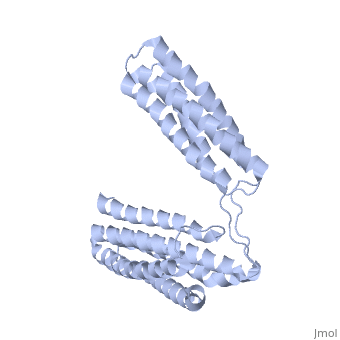2x0c
From Proteopedia
(Difference between revisions)
| (7 intermediate revisions not shown.) | |||
| Line 1: | Line 1: | ||
| - | [[Image:2x0c.png|left|200px]] | ||
| - | + | ==Crystal Structure of the R7R8 domains of Talin== | |
| + | <StructureSection load='2x0c' size='340' side='right'caption='[[2x0c]], [[Resolution|resolution]] 2.00Å' scene=''> | ||
| + | == Structural highlights == | ||
| + | <table><tr><td colspan='2'>[[2x0c]] is a 1 chain structure with sequence from [https://en.wikipedia.org/wiki/Mus_musculus Mus musculus]. Full crystallographic information is available from [http://oca.weizmann.ac.il/oca-bin/ocashort?id=2X0C OCA]. For a <b>guided tour on the structure components</b> use [https://proteopedia.org/fgij/fg.htm?mol=2X0C FirstGlance]. <br> | ||
| + | </td></tr><tr id='method'><td class="sblockLbl"><b>[[Empirical_models|Method:]]</b></td><td class="sblockDat" id="methodDat">X-ray diffraction, [[Resolution|Resolution]] 2Å</td></tr> | ||
| + | <tr id='resources'><td class="sblockLbl"><b>Resources:</b></td><td class="sblockDat"><span class='plainlinks'>[https://proteopedia.org/fgij/fg.htm?mol=2x0c FirstGlance], [http://oca.weizmann.ac.il/oca-bin/ocaids?id=2x0c OCA], [https://pdbe.org/2x0c PDBe], [https://www.rcsb.org/pdb/explore.do?structureId=2x0c RCSB], [https://www.ebi.ac.uk/pdbsum/2x0c PDBsum], [https://prosat.h-its.org/prosat/prosatexe?pdbcode=2x0c ProSAT]</span></td></tr> | ||
| + | </table> | ||
| + | == Function == | ||
| + | [https://www.uniprot.org/uniprot/TLN1_MOUSE TLN1_MOUSE] Probably involved in connections of major cytoskeletal structures to the plasma membrane. High molecular weight cytoskeletal protein concentrated at regions of cell-substratum contact and, in lymphocytes, at cell-cell contacts. | ||
| + | == Evolutionary Conservation == | ||
| + | [[Image:Consurf_key_small.gif|200px|right]] | ||
| + | Check<jmol> | ||
| + | <jmolCheckbox> | ||
| + | <scriptWhenChecked>; select protein; define ~consurf_to_do selected; consurf_initial_scene = true; script "/wiki/ConSurf/x0/2x0c_consurf.spt"</scriptWhenChecked> | ||
| + | <scriptWhenUnchecked>script /wiki/extensions/Proteopedia/spt/initialview01.spt</scriptWhenUnchecked> | ||
| + | <text>to colour the structure by Evolutionary Conservation</text> | ||
| + | </jmolCheckbox> | ||
| + | </jmol>, as determined by [http://consurfdb.tau.ac.il/ ConSurfDB]. You may read the [[Conservation%2C_Evolutionary|explanation]] of the method and the full data available from [http://bental.tau.ac.il/new_ConSurfDB/main_output.php?pdb_ID=2x0c ConSurf]. | ||
| + | <div style="clear:both"></div> | ||
| + | <div style="background-color:#fffaf0;"> | ||
| + | == Publication Abstract from PubMed == | ||
| + | Talin is an adaptor protein that couples integrins to F-actin. Structural studies show that the N-terminal talin head contains an atypical FERM domain while the N- and C-terminal parts of the talin rod comprise a series of alpha-helical bundles. However, determining the structure of the central part of the rod has proved problematic. Residues 1359-1659 are homologous to the MESDc1 gene product, and we therefore expressed this region of talin in E. coli. The crystal structure shows a unique fold comprised of a 5- and 4-helix bundle. The 5-helix bundle is composed of non-sequential helices due to insertion of the 4-helix bundle into the loop at the C-terminus of helix alpha3. The linker connecting the bundles forms a two-stranded anti-parallel beta-sheet likely limiting the relative movement of the two bundles. Because the 5-helix bundle contains the N- and C-termini of this module, we propose that it is linked by short loops to adjacent bundles while the 4-helix bundle protrudes from the rod. This suggests the 4-helix bundle has a unique role, and its pI (7.8) is higher than other rod domains. Both helical bundles contain vinculin-binding sites, but that in the isolated 5-helix bundle is cryptic whereas that in the isolated 4-helix bundle is constitutively active. In contrast, both bundles are required for actin binding. Finally, we show that the MESDc1 protein, which is predicted to have a similar fold, is a novel actin binding protein. | ||
| - | + | The central region of talin has a unique fold that binds vinculin and actin.,Gingras AR, Bate N, Goult BT, Patel B, Kopp PM, Emsley J, Barsukov IL, Roberts GC, Critchley DR J Biol Chem. 2010 Jul 7. PMID:20610383<ref>PMID:20610383</ref> | |
| - | + | From MEDLINE®/PubMed®, a database of the U.S. National Library of Medicine.<br> | |
| - | + | </div> | |
| - | + | <div class="pdbe-citations 2x0c" style="background-color:#fffaf0;"></div> | |
| - | + | ||
==See Also== | ==See Also== | ||
*[[Talin|Talin]] | *[[Talin|Talin]] | ||
| - | + | *[[Talin 3D structures|Talin 3D structures]] | |
| - | == | + | == References == |
| - | < | + | <references/> |
| + | __TOC__ | ||
| + | </StructureSection> | ||
| + | [[Category: Large Structures]] | ||
[[Category: Mus musculus]] | [[Category: Mus musculus]] | ||
| - | [[Category: Barsukov | + | [[Category: Barsukov IL]] |
| - | [[Category: Bate | + | [[Category: Bate N]] |
| - | [[Category: Critchely | + | [[Category: Critchely DR]] |
| - | [[Category: Emsley | + | [[Category: Emsley J]] |
| - | [[Category: Gingras | + | [[Category: Gingras AR]] |
| - | [[Category: Goult | + | [[Category: Goult BT]] |
| - | + | ||
| - | + | ||
| - | + | ||
| - | + | ||
| - | + | ||
| - | + | ||
| - | + | ||
| - | + | ||
Current revision
Crystal Structure of the R7R8 domains of Talin
| |||||||||||


